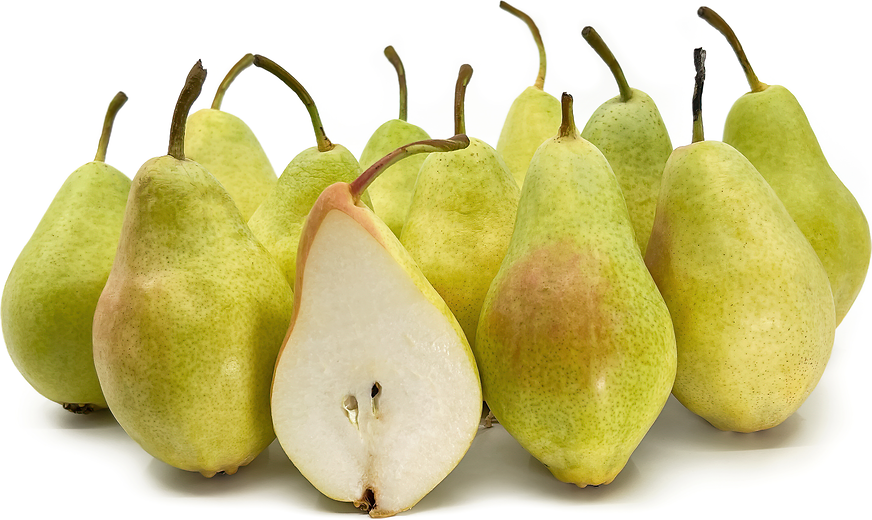


Santa Maria Pears
Estimated Inventory, lb : 0
Description/Taste
Santa Maria pears are large, uniform fruits, averaging 4 to 6 centimeters in diameter and 6 to 8 centimeters in length, and have an elongated, oval to pyriform shape. The skin is smooth, thin, covered in prominent lenticels, and has a yellow-green base with pink blush on the sides with the most sun exposure. It is important to note that the skin may also turn completely yellow when kept in cold storage. Underneath the surface, the flesh is crisp, aqueous, white, oily, and fine-grained, encasing a slender central core with a few black-brown seeds. Santa Maria pears are aromatic, and when ripe, they develop a soft, tender texture with a sweet, subtly tart flavor.
Seasons/Availability
Santa Maria pears are harvested in the late summer through early fall and can be stored until the mid-winter.
Current Facts
Santa Maria pears, botanically classified as Pyrus communis, are an early-autumn variety that belongs to the Rosaceae family. The sweet fruits are native to Italy and have become a favored dessert variety throughout European and Russian markets. Santa Maria pears are commercially cultivated and grown in home gardens, valued by farmers for their sweet flavor, uniform shape, extended storage capabilities, and high yields. In Italy, the variety is often given the nickname of the “generous pear,” as the trees can produce up to 120 kilograms of large, juicy fruits. Santa Maria pears are primarily consumed fresh, but the fruits can also be used in a wide variety of juices, baked goods, and condiments.
Nutritional Value
Santa Maria pears are an excellent source of fiber, which can help regulate digestion, and are a good source of vitamins A, C, and E, which contain antioxidants that can help protect the immune system and reduce signs of aging. The fruits also provide some copper, magnesium, folate, phosphorus, potassium, calcium, and iron.
Applications
Santa Maria pears are best suited for raw applications as their sweet, juicy flesh is showcased when consumed straight, out-of-hand. The pears can be sliced and eaten as a snack, or they can be tossed into green and fruit salads, blended into smoothies, or pressed into juice for fruit drinks, ciders, and cocktails. In Russia, kvass is a fermented beverage that incorporates pears, ginger, and cinnamon to make a health-focused drink for the digestive tract. Santa Maria pears can also be sliced and layered on bruschetta, layered over pizza, dipped whole into candy coatings and chocolate, or used as a fresh topping for ice cream. In addition to raw applications, Santa Maria pears can be cooked into compotes, jams, and honey, or baked into tarts, muffins, cobblers, and cakes. In Italy, Santa Maria pears are frequently combined with mascarpone and baked into a light and fluffy cake that is served as a dessert, breakfast item, or afternoon tea accompaniment. Santa Maria pears complement flavors of fruits such as persimmons, apples, blackberries, and plums, raisins, meats such as smoked ham, veal, pork, and poultry, broccoli, endive, arugula, cheeses such as goat, gorgonzola, blue, brie, and parmesan, nuts such as walnuts, pecans, pine nuts, and almonds, caramel, honey, and vanilla. The fresh fruits will keep 2-8 weeks, depending on the degree of ripeness, when stored in the refrigerator.
Ethnic/Cultural Info
In Italy, Santa Maria pears are grown by a collective of Italian fruit growers known as Opera. The organization was named after the theatrical genre and classical music style, also created in Italy and is meant to symbolize the pears as works of art. There are over one thousand growers belonging to Opera, and the orchards are located in the Po Valley, which is one of the most famous and fertile regions for pear cultivation in northern Italy. Opera oversees the entire cultivation process from growing, collecting, storing, to shipping, and exports to countries throughout Europe, often giving Italy the reputation for being one of the top market leaders in pear exports.
Geography/History
Santa Maria pears are native to Italy and were created by breeder Alessandro Moretinni at the University of Florence. The variety was created from a cross between coscia and old williams pears and was released to commercial markets in 1951. Today Santa Maria pears are commercially cultivated in the Emilia-Romagna region of northern Italy and are exported to markets throughout Europe. The pears are also grown on a smaller scale through farms and home gardens in Turkey, Southern Russia, and Central Asia.
Recipe Ideas
Recipes that include Santa Maria Pears. One
| Doctor Wine |
|
Rabbit Pate with a Santa Maria Pear and Ginger Sauce |
| Oh So Delicioso |
|
Grilled Pear and Halloumi Salad |















